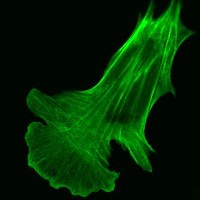
LifeAct, coupled to green fluorescent protein, colors the actin cytoskeleton (Max Planck Institute for Biochemistry)
The Max Planck Society, through its technology transfer affiliate Max Planck Innovation GmbH in Munich, Germany, has awarded an exclusive license for the peptide LifeAct to ibidi GmbH, a provider of cell analysis products, located in Martinsried, Germany. The peptide allows for actin, an important protein in a cell’s cytoskeleton, to be made visible in living cells without disturbing actin-dependent processes.
Actin is the part of the cytoskeletal system that allows movement of cells and cellular processes, working together or in tandem with other components. Like the other components, actin can undergo constant rearrangement to produce movement. Actin filaments are also called microfilaments, or “thin filaments” to distinguish them from intermediate filaments. The filaments are used as supply routes for molecular loads in the cell and other purposes. Thus actin plays an important role in a wide array of functions such as in the development of organs and the movement of cells.
Max Planck Innovation says markers are available that allow for the visualization of actin, but they also interfere with its activity. The actin marker LifeAct, however, now licensed by ibidi, attaches itself to the structural protein without limiting its function. LifeAct, only 17 amino-acids long, is linked to a fluorescent dye, which makes it possible to follow the development and movement in living cells. Max Planck Innovation says the marker has already been used successfully in yeast cells, kidney cells, white blood cells, neuron and a variety of other cell types and tissues.
The ibidi GmbH develops produces and distributes micro-slides for the functional analysis of living cells in microscopy. The micro-slide family consists of different slide types for cell culture and high-end microscopy.

 RSS - Posts
RSS - Posts
You must be logged in to post a comment.